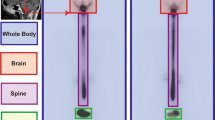Abstract
Hydrocephalic brain edema has become widely recognized since the introduction of computer tomography (CT). On CT scan, edema is seen especially in the periventricular white matter, where it is familiar as periventricular lucency or periventricular hypodensity (PVH) [13, 14, 17]. Our previous study with metrizamide CT scanning showed transependymal migration of metrizamide in the area of PVH. The iodine concentration was highest in the periventricular white matter according to measurement by the cerate-arsenite method. The specific gravity was particularly low in the periventricular white matter of the hydrocephalic brains in which it was measured by means of a gradient column containing kerosene and bromobenzene. On the basis of these facts edema is interpreted as transependymal migration of cerebrospinal fluid (CSF) into the brain [6–8].
Access this chapter
Tax calculation will be finalised at checkout
Purchases are for personal use only
Preview
Unable to display preview. Download preview PDF.
Similar content being viewed by others
References
Drayer BP, Gur D, Wolfson SK, Cook EE (1980) Experimental xenon enhancement with CT imaging; cerebral applications. Am J Neuroradiol 1:3–8
Drayer BP, Wolfson SK, Reinmuth OM, Dujovny M, Boehnke M, Cook EE (1978) Xenon enhanced CT for analysis of cerebral integrity, perfusion, and blood flow. Stroke 9:123–130
Gur D, Good WF, Wolfson SK, Yonas H, Shabason L (1982) In vivo mapping of local cerebral blood flow by xenon-enhanced computed tomography. Science 215:1267–1268
Gur D, Wolfson SK, Yonas H, Good WF, Shabason L, Latchaw RE, Miller DM, Cook EE (1982) Progress in cerebrovascular disease: local cerebral blood flow by xenon-enhanced CT. Stroke 13:750–758
Hassler O (1964) Angioarchitecture in hydrocephalus. An autopsy and experimental study with the aid of microangiography. Acta Neuropathol 4:65–74
Hiratsuka H, Fujiwara K, Okada K, Takasato Y, Tsuyumu M, Inaba Y (1980) Modification of periventricular hypodensity in hydrocephalus with ventricular reflux in metriza-mide CT cisternography. J Comput Assist Tomogr 2:471–474
Hiratsuka H, Tabata H, Tsuruoka S, Aoyagi M, Okada K, Inaba Y (1982) Evaluation of periventricular hypodensity in experimental hydrocephalus by metrizamide CT ventriculograph. J Neurosurg 56:235–240
Inaba Y, Hiratsuka H, Tsuyumu M, Tabata H, Tsuruoka S (1984) Evaluation of periventricular hypodensity in clinical and experimental hydrocephalus by metrizamide computed tomography. In: Go G, Baethmann A (eds) Recent progress in the study and therapy of brain edema. Plenum, New York, pp 299–310
Ishii N, Momii S, Suzuki T, Ito K (1980) CT findings of multi-infarct dementia with particular reference to periventricular lucency. Neurol Med 12:376–381
Lassen NA, Henriksen L, Paulson OB (1981) Regional cerebral blood flow in stroke by xenon-133 inhalation and emission tomography. Stroke 12:284–288
Meyer JS, Hayman A, Amano T, Nakajima S, Shaw T, Lauzon P, Derman S, Karacan I, Harati Y (1981) Mapping local blood flow of human brain by CT scanning during stable xenon inhalation. Stroke 12:426–436
Meyer JS, Hayman LA, Yamamoto M, Sakai F, Nakajima S (1980) Local cerebral blood flow measured by CT after stable xenon inhalation. Am J Neuroradiol 1:213–225
Mosely IF, Radu EW (1979) Factors influencing the development of periventricular lucencies in patients with raised intracranial pressure. Neuroradiology 17:65–69
Naidich TP, Epstein F, Lin JP et al. (1976) Evaluation of pediatric hydrocephalus by computed tomography. Radiology 119:337–345
Obrist WD, Thompson HK, Wang HS, Wilkinson WE (1975) Regional cerebral blood flow estimated by 133 xenon inhalation. Stroke 6:245–256
Ohya M (1984) Changes of cerebral microvasculature in experimental hydrocephalus and its relation to periventricular lucency. Nervous System Children 9:173–181
Pasquini U, Bronzini M, Gozzoli E et al. (1977) Periventricular hypodensity in hydrocephalus: a clinicoradiological and mathematical analysis using computed tomography. J Comput Assist Tomogr 1:443–448
Phelps ME, Mazziotta JC, Huang SC (1982) Study of cerebral function with positron computed tomography. J Cereb Blood Flow Metab 2:113–163
Segawa H, Wakai S, Tamura A, Yoshimasu N, Nakamura O, Ohta M (1983) Computed tomographic measurement of local cerebral blood flow by xenon enhancement. Stroke 14:356–362
Suzuki R, Hiratsuka H, Ohno K, Inaba Y, Kimura T, Inoue J (1985) Topographic mapping of regional cerebral blood flow by xenon-enhanced CT — Introducing a simplified method as a routine examination. Brain Nerve 37:73–80
Wozniak M, McLone DG, Raimondi AJ (1975) Micro- and macrovascular changes as the direct cause of parenchymal destruction in congenital murine hydrocephalus. J Neurosurg 43:535–545
Yamanouchi H, Tohgi H, Tomonaga M, Iio M (1981) Computerized tomographic evaluation of chronic ischemic lesions in cerebral white matter. Jpn J Geriat 18:297–307
Author information
Authors and Affiliations
Editor information
Editors and Affiliations
Rights and permissions
Copyright information
© 1985 Springer-Verlag Berlin Heidelberg
About this paper
Cite this paper
Hiratsuka, H. et al. (1985). Regional Cerebral Blood Flow in Experimental Hydrocephalus of Dogs, Measured by Xenon-Enhanced CT. In: Inaba, Y., Klatzo, I., Spatz, M. (eds) Brain Edema. Springer, Berlin, Heidelberg. https://doi.org/10.1007/978-3-642-70696-7_76
Download citation
DOI: https://doi.org/10.1007/978-3-642-70696-7_76
Publisher Name: Springer, Berlin, Heidelberg
Print ISBN: 978-3-642-70698-1
Online ISBN: 978-3-642-70696-7
eBook Packages: Springer Book Archive




